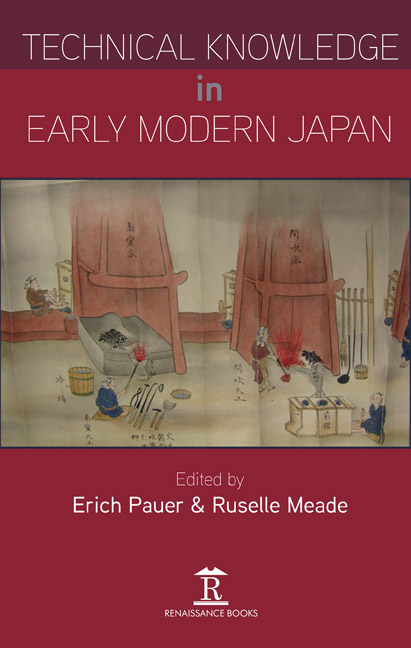Book contents
- Frontmatter
- Contents
- Acknowledgements
- Introduction: Remarks on the History of Technology in Japan
- 1 Production Techniques in Early Modern Japan as seen through ‘Famous Products of Japan from Mountain and Sea, Illustrated’ (Nippon sankai meisan zue, 1799)
- 2 Vehicles of Knowledge: Japanese Technical Drawings in the Pre-modern Era, 1600–1868
- 3 Dissemination of Knowledge and Technology: The Extensive Range of Exhibitions in Japan in the Eighteenth and Nineteenth Centuries
- 4 Knowledge on Mining and Smelting and Its Dissemination in the Edo Period
- 5 Tanaka Hisashige and His Myriad Year Clock: Its Technological Characteristics and Historical Background
- 6 A Statistical Analysis of Tōkyō Meikō Kagami (with a Focus on Highly Skilled Metalwork Craftsmen)
- 7 Boiler Manufacture in Late-nineteenth Century Japan: From First Beginnings to Nationwide Expansion
- Appendix: Selected Sources on the Japanese History of Technology (especially on series)
- List of Contributors
- Index
4 - Knowledge on Mining and Smelting and Its Dissemination in the Edo Period
Published online by Cambridge University Press: 30 April 2022
- Frontmatter
- Contents
- Acknowledgements
- Introduction: Remarks on the History of Technology in Japan
- 1 Production Techniques in Early Modern Japan as seen through ‘Famous Products of Japan from Mountain and Sea, Illustrated’ (Nippon sankai meisan zue, 1799)
- 2 Vehicles of Knowledge: Japanese Technical Drawings in the Pre-modern Era, 1600–1868
- 3 Dissemination of Knowledge and Technology: The Extensive Range of Exhibitions in Japan in the Eighteenth and Nineteenth Centuries
- 4 Knowledge on Mining and Smelting and Its Dissemination in the Edo Period
- 5 Tanaka Hisashige and His Myriad Year Clock: Its Technological Characteristics and Historical Background
- 6 A Statistical Analysis of Tōkyō Meikō Kagami (with a Focus on Highly Skilled Metalwork Craftsmen)
- 7 Boiler Manufacture in Late-nineteenth Century Japan: From First Beginnings to Nationwide Expansion
- Appendix: Selected Sources on the Japanese History of Technology (especially on series)
- List of Contributors
- Index
Summary
INTRODUCTION: MINING IN JAPAN
ALTHOUGH JAPAN IS today widely considered to be lacking in natural mineral resources, the country did have rich ore deposits in historical times. Gold, silver and copper deposits were concentrated in the Tōhoku region and the Kansai area. Gold deposits were also found on the island of Sado, in the mountains of the Kantō region, on the Izu peninsula, and in Satsuma (present-day Kagoshima prefecture), and copper was mined in many parts of Japan.
During the Edo period (1600–1868), among the most important mines were the silver mines of Iwami/Ōmori (Shimane), Ikuno (Hyōgo) and Innai (Akita), the gold mines of Sado (Niigata), the Tōhoku area, the prefectures of Yamanashi and Kagoshima, as well as the copper mines of Ani (Akita) and Besshi (Ehime) (see Fig. 1).
At the end of the Edo period, iron was found mainly in the form of sand iron in many parts of the country, but especially in western Honshū, in the prefectures of Shimane and Tottori. Deposits of lead and tin, which were important for processing gold, silver and copper, were relatively small, and so some of these ores had to be imported.
This chapter focuses on gold, silver and copper mining and the knowledge and technology necessary for successfully carrying out mining of these minerals. Iron was the most consumed metal, and thus the most intensively mined. Despite its importance, techniques for extracting and processing its raw material, sand iron, have hardly evolved over the centuries. In contrast, the development and dissemination of new knowledge played an important role in the increase in mining of precious metals during the late sixteenth and early seventeenth centuries.
Knowledge related to mining roughly covers the following areas:
• Finding the deposits: Prospecting, surveying
• Work underground: Heading, drifting, mining, ore extraction, transport, drainage and ventilation
• Further processing: Dressing – smelting – refining
Until the end of the Edo period, knowledge in all of these areas was essentially empirical, and was sometimes supplemented with cosmological knowledge for activities such as prospecting.
DEVELOPMENT OF MINING AND MINING TECHNOLOGY BEFORE THE SIXTEENTH CENTURY
Metals were first used in Japan during the Yayoi period (ca 400 BCE to 300 CE), when metal tools and knowledge about metal processing were gradually introduced from China and Korea.
- Type
- Chapter
- Information
- Technical Knowledge in Early Modern Japan , pp. 69 - 95Publisher: Amsterdam University PressPrint publication year: 2020

